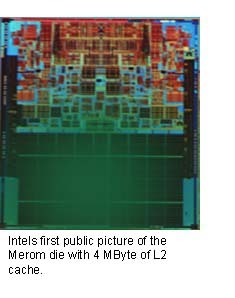Intel: A new architecture for the next decade
San Francisco (CA) - As expected, Intel announced at its developer forum a new processor architecture that will enable the company to capitalize on a growing need for power-efficient computing: A single architecture will deliver the ingredients for next-generation mobile, desktop and server processors.
After years of driving Megahertz and Gigahertz higher at a quickly accelerating pace, there is revolutionary change ahead for the world's largest chip manufacturer. Intel said it recognized a "fundamental shift in how computers are used" and decided to take processors to a model of "usage oriented computing." While performance is expected to climb in the future, the company increasingly focuses on how to decrease the amount of power that is needed for the additional speed.
Intel did not provide many details on the new architecture, which is yet to be given a name. While the features as well as the development path indicate that the new architecture is based in many parts on the current Pentium M architecture, the company stated it is a product that has been designed from the ground up. It was explained that the hardware designers took the best elements of the Pentium M "Banias" architecture - such as power saving features - as well as some functionalities of the current Netburst model of the Pentium 4 - such as the quad-pumped bus - to create the new architecture that will appear in desktop, mobile and server processors in the second half of 2006.
While sharing the same core, the three chips will offer features unique to their target applications. For example, Merom will be tailored to deliver the lowest power consumption of the three architecture versions. Intel expects the processor to keep a maximum power consumption level of the current Pentium M (about 21 watts) and a low-voltage version to come in at about 5 watts. The desktop chip will consume no more than 65 watts (down from 130 watts today) and the server version not more than 80 watts. Distinct architecture differences also include the size of the L2 cache. Merom will integrate 4 MByte L2 cache, Conroe chips 4 MByte and 8 MByte, and Woodcrest 8 MByte. A 4-core version of Woodcrest, codenamed Whitefield, will offer 32 MByte of L2 cache.
Intel did not provide details on the power saving features of Conroe and Woodcrest - other than saying that a switch to a 65 nm production process was critical - but indicated that the foundation what the company has learned with the current Pentium M and the upcoming Yonah will be carried over to Merom. Additionally, Merom will be able to shut down one of its two cores, if it is not needed.
Interestingly, Merom will be introduced as a "refresh" of the Napa platform, which will debut early next year with the Yonah dual-core processor at its heart. According to Intel, Merom will support Napa's "Calistoga" chipset, allowing customers to simply substitute a Yonah with a Merom processor on a Napa board. However, in order to enable all of Merom's new features, users will have to wait for a chipset that is designed for the new processor architecture.
Hyperthreading appears to become an increasingly obsolete feature, at least in processors for the mainstream. Merom will not support Hyperthreading, as the technology would have consumed too much power, according to Intel. The same goes for Conroe desktop processors. However, virtual threading is not completely off the table and may still be a valuable tool to differentiate higher-end processors, such as Intel's Extreme Editions and server chips, from the mainstream.
Get Tom's Hardware's best news and in-depth reviews, straight to your inbox.
Stephen Smith, vice president of the digital enterprise group, told Tom's Hardware Guide that Merom, Conroe and Woodcrest have entered Intel's validation process with systems booting multiple operating systems. Compared to the Pentium D (Smithfield core), which was considered a "time-to-market" product that required an accelerated validation process, the debugging procedure of the new architecture will take more time, although Smith mentioned that the process runs "very smoothly" at this time. He declined to comment on an introduction time, but industry sources indicated that October 2006 "would be a good guess."
With new dual-cores and a new architecture just about a year away, the single-core platforms were left aside at IDF. However, single-core processors based on the 65 nm Cedar Mill core (Pentium 4) and the 65 nm Yonah chip will not go away anytime soon. Intel will keep single-cores in its product line until 2007 and beyond - even if the company expects multi-core shipments to have reached more than 90 percent of its desktop chip production, more than 90 percent in the mobile segment and 100 percent in the server range by that time.

Wolfgang Gruener is an experienced professional in digital strategy and content, specializing in web strategy, content architecture, user experience, and applying AI in content operations within the insurtech industry. His previous roles include Director, Digital Strategy and Content Experience at American Eagle, Managing Editor at TG Daily, and contributing to publications like Tom's Guide and Tom's Hardware.
